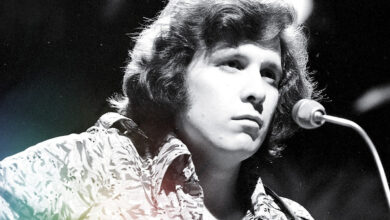The Who delivered a stunningly heartfelt performance of ” Behind Blue Eyes”
“Behind Blue Eyes” is a poignant ballad by the legendary British rock band The Who, known for their electrifying performances and groundbreaking contributions to the rock genre. Released in 1971 as a part of their iconic album “Who’s Next,” the song showcases the band’s ability to blend introspective lyrics with powerful instrumentation, resulting in a deeply emotional and captivating listening experience.
The song’s protagonist expresses feelings of loneliness, isolation, and vulnerability, captured eloquently in the opening lines: “No one knows what it’s like to be the bad man, to be the sad man, behind blue eyes.” Through these lyrics, the singer conveys a sense of inner turmoil and frustration, painting a vivid portrait of someone grappling with inner demons and struggling to find solace in a world that often feels unforgiving.
Musically, “Behind Blue Eyes” is characterized by its haunting melody, haunting acoustic guitar, and emotive vocal delivery by lead singer Roger Daltrey. The song builds gradually, drawing listeners in with its evocative atmosphere and subtle instrumentation, before erupting into a powerful crescendo during the climactic chorus.
One of the most striking aspects of “Behind Blue Eyes” is its universal appeal, resonating with listeners across generations and transcending cultural boundaries. The song’s themes of alienation, longing, and the quest for understanding are relatable to people from all walks of life, making it a timeless classic that continues to endure decades after its release.
The Who’s performance of “Behind Blue Eyes” is nothing short of stunning, showcasing the band’s raw talent and emotional depth. Roger Daltrey’s soulful vocals, accompanied by Pete Townshend’s masterful guitar work and the rhythmic precision of John Entwistle and Keith Moon, create a sonic landscape that is both mesmerizing and profoundly moving.
The song’s impact extends beyond its musical merits, serving as a powerful reflection of the human condition and the complexities of the human experience. Whether performed live on stage or heard through headphones, “Behind Blue Eyes” has a way of touching the hearts and souls of all who encounter it, leaving a lasting impression that lingers long after the final notes fade away.
Roger Daltrey, born on March 1, 1944, in London, England, is renowned as the lead vocalist and founding member of The Who. With his distinctive voice and charismatic stage presence, Daltrey played a pivotal role in shaping the band’s sound and image, helping to propel them to international stardom.
Daltrey’s journey as a musician began in the early 1960s when he formed The Detours, a band that would later evolve into The Who. Known for his powerful vocals and dynamic stage persona, Daltrey quickly emerged as one of the most influential frontmen in rock history, captivating audiences with his electrifying performances and magnetic stage presence.
Throughout his career, Daltrey has received widespread acclaim for his contributions to music and the arts, earning numerous awards and accolades, including induction into the Rock and Roll Hall of Fame as a member of The Who. Beyond his work with the band, Daltrey has also pursued a successful solo career, releasing several albums and collaborating with various artists across different genres.
In addition to his musical endeavors, Daltrey is also known for his philanthropic efforts, supporting charitable causes related to cancer research, children’s healthcare, and veterans’ services. His commitment to using his platform for good reflects his passion for making a positive impact on the world beyond the realm of music.
Overall, “Behind Blue Eyes” stands as a testament to The Who’s enduring legacy and Roger Daltrey’s remarkable talent as a vocalist and performer. With its heartfelt lyrics, stirring melody, and powerful delivery, the song continues to resonate with audiences around the globe, reminding us of the profound emotional connection that music can create.





